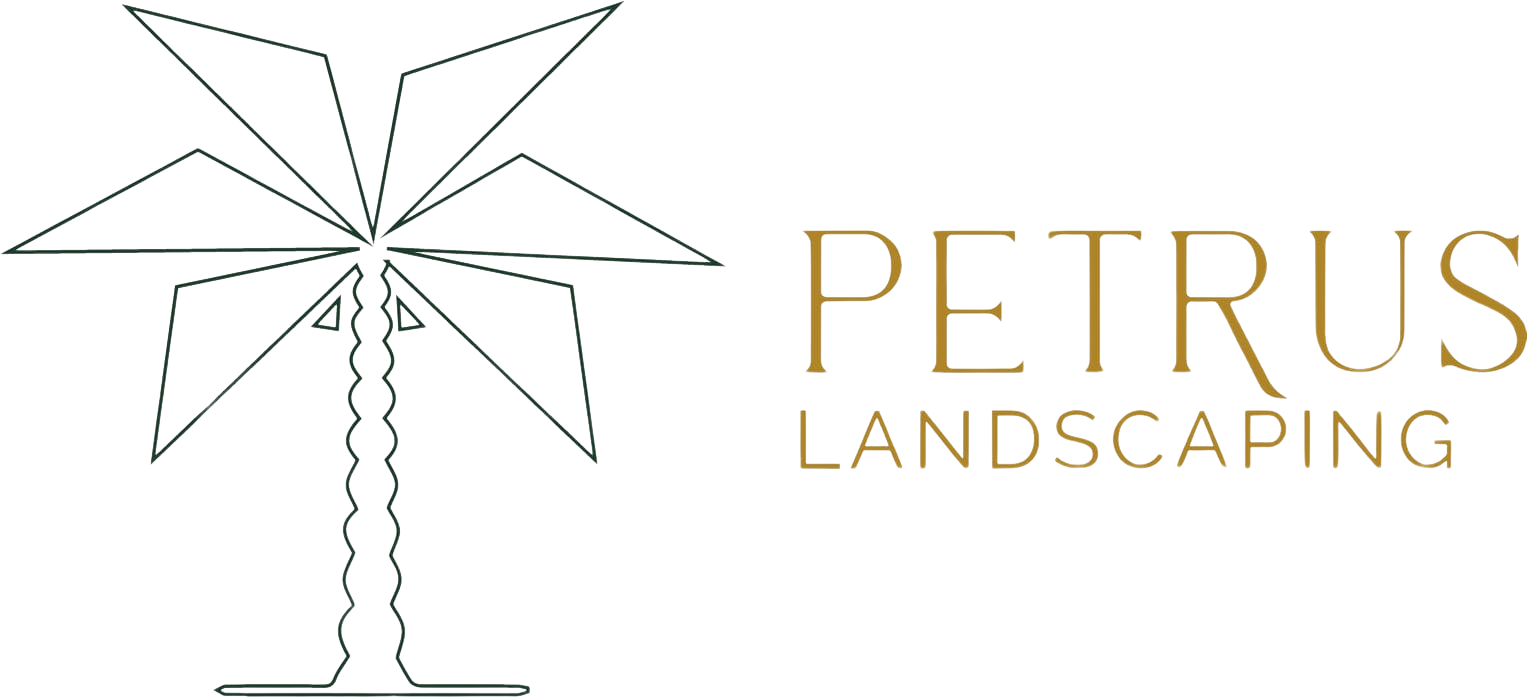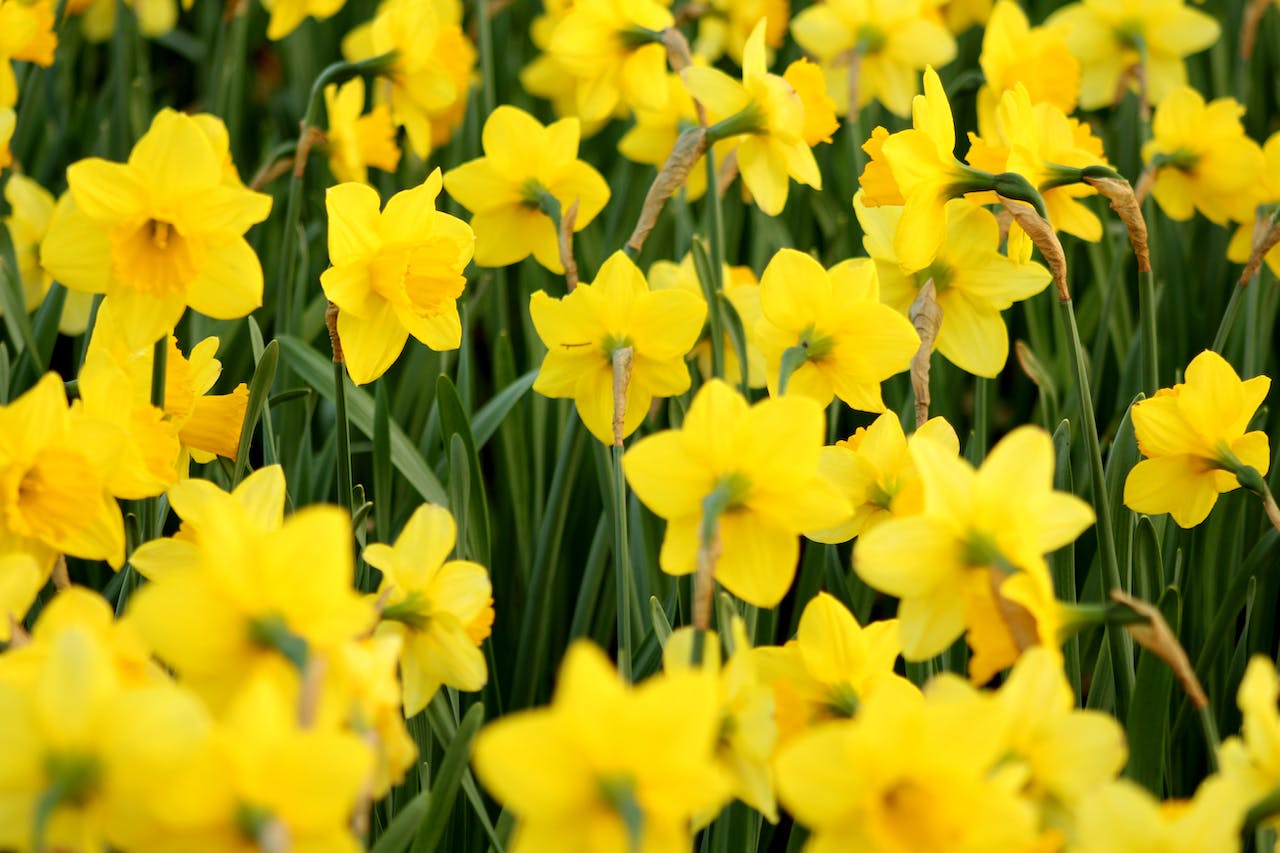Why Alliums?
You might wonder, what makes Alliums such valuable additions to your garden design? Alliums are renowned for their striking appearance, which seamlessly blends elegance with a touch of the exotic. Their globe-shaped flower heads are truly unique and captivating. These ornamental onions add a sense of structure and form to your garden, breaking away from more common flower shapes. Furthermore, Alliums are relatively low-maintenance, thriving in a variety of soil types and requiring minimal care once established. They provide visual interest both in bloom and as seed heads, adding depth to your garden’s appearance. With a selection of Allium varieties that bloom at different times, you can orchestrate a long-lasting display of color and form in your garden throughout the growing season. These flowers also attract pollinators, making them valuable contributors to your local ecosystem. In essence, Alliums have the remarkable ability to transform your garden into a unique and unforgettable landscape.
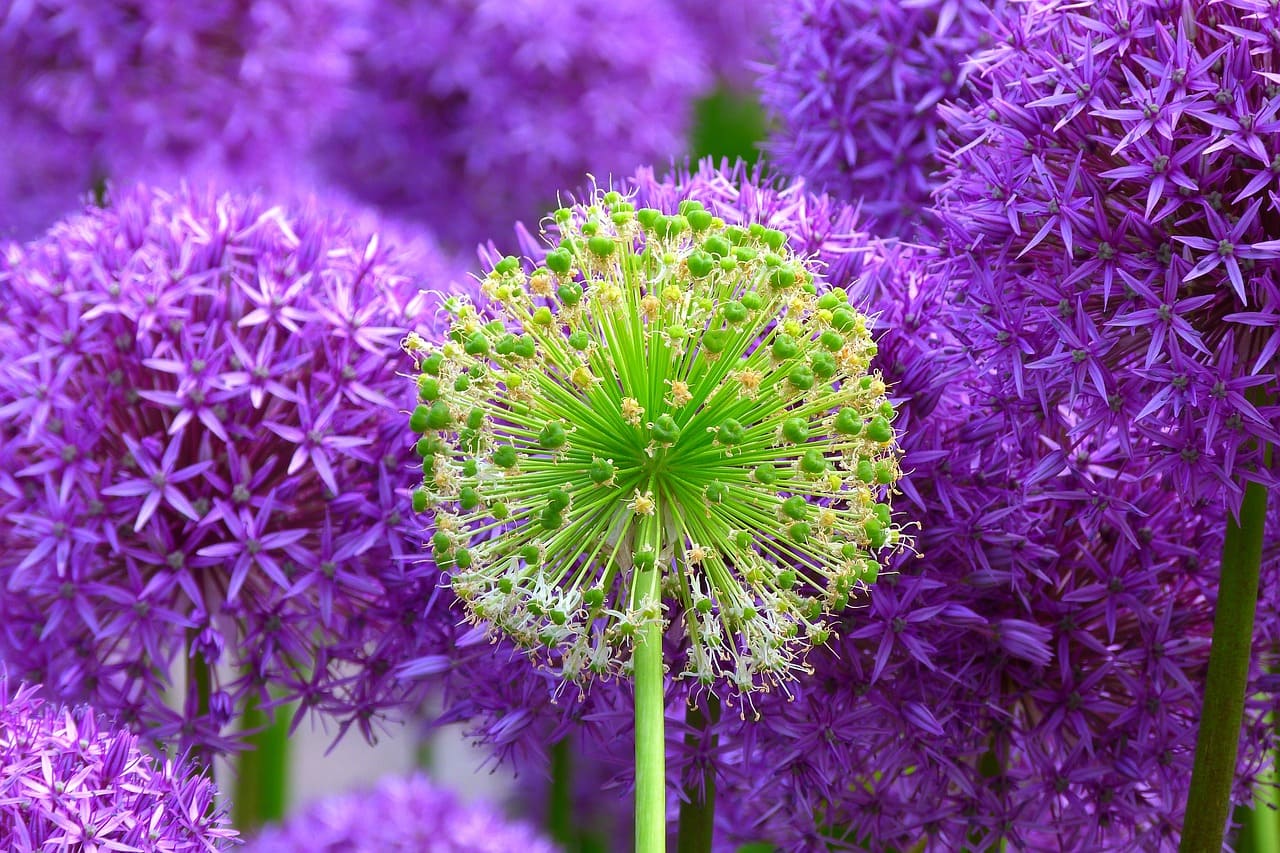
Alliums – The Floral Globetrotters
Meet the Alliums: A brief introduction to the ornamental onions.
Alliums, often referred to as ornamental onions, are a diverse and captivating group of flowering plants that can add unique character to your garden. These ornamental onions belong to the Allium genus, which is an extensive group encompassing hundreds of species. Alliums are characterized by their globe-shaped flower heads and a distinct pungent aroma resembling their edible relatives, onions and garlic. These plants have made a name for themselves as prominent figures in the world of ornamental gardening due to their striking appearance and easy-going nature. As we journey through the enchanting world of Alliums, we’ll explore some notable varieties and how they can elevate your garden’s aesthetics.
Allium ‘Globemaster’ – The Royal Purple: Description, blooming season, and visual impact.
Among the plethora of Allium varieties, ‘Globemaster’ stands as one of the most celebrated. This regal Allium produces large, spherical flower heads that can reach up to an astonishing 10 inches in diameter. ‘Globemaster’ graces your garden with individual flowers of deep, royal purple, creating a captivating visual display. Its majestic presence often draws eyes and praise, making it an excellent choice as a focal point in your garden. Typically, ‘Globemaster’ blooms in late spring to early summer, perfectly aligning with the time when gardens come to life. The grandeur of ‘Globemaster’ lends itself beautifully to various garden styles, whether you opt for a formal garden or a more relaxed, cottage-style space.
Allium ‘Mount Everest’ – The Majestic White: Unique features, blooming period, and design versatility.
If you prefer large, white blossoms that evoke a sense of majesty, ‘Mount Everest’ is an exceptional choice. These Alliums produce enormous, globe-shaped flower heads in pristine white, perched atop tall, graceful stems that can reach heights of 3 to 4 feet. The white flowers of ‘Mount Everest’ create a stunning contrast in your garden, particularly when planted alongside other vibrant perennials. These elegant Alliums typically grace your garden with their presence in late spring, adding a sense of purity and refinement to the landscape. ‘Mount Everest’ offers a striking visual impact, whether you plant them in clusters or weave them among other ornamental companions. Their design versatility allows for various creative arrangements in your garden design.
Allium atropurpureum – The Dramatic Drama: Characteristics, size, and flowering synchronization.
If you’re on the lookout for a smaller yet dramatically hued Allium, ‘Atropurpureum’ deserves your attention. These Alliums produce petite, egg-shaped flower heads in rich burgundy-red to near-black shades, making them a standout feature in any garden. They typically reach a height of about 12 to 18 inches, a more compact size compared to their larger Allium counterparts. One intriguing aspect of ‘Atropurpureum’ is its synchronized flowering time with other Alliums. The combination of their deep, dramatic color and their ability to bloom in harmony with other varieties makes ‘Atropurpureum’ a fantastic choice. You can create a dramatic ambiance in your garden by planting them alongside ‘Globemaster’ or ‘Mount Everest’ for a rich visual contrast. These smaller Alliums also work beautifully in rock gardens, borders, or even containers.
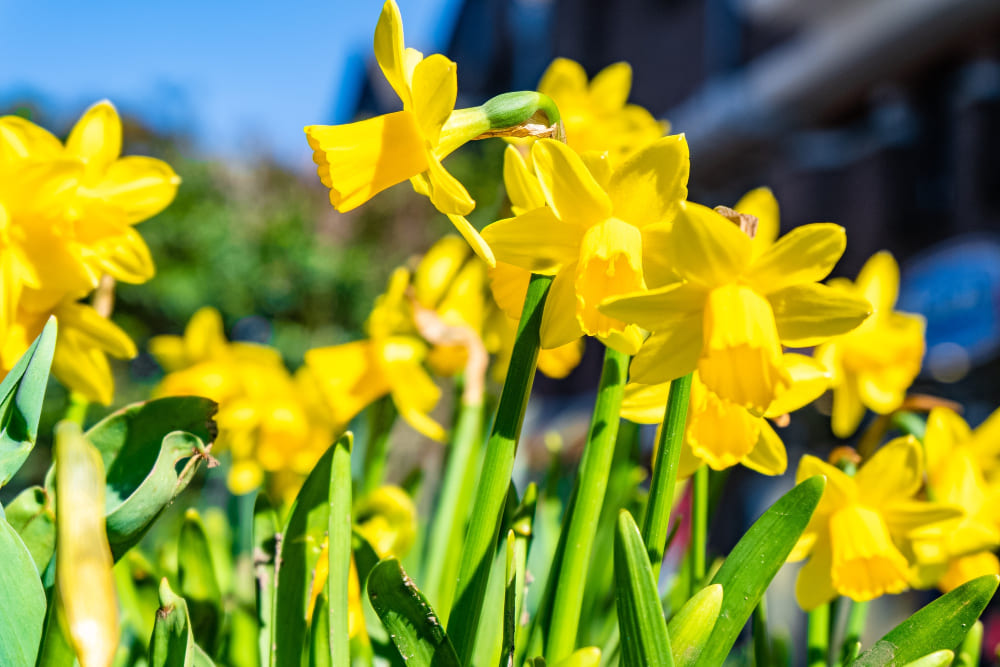
Narcissus – The Sunshine Emissaries
The Artistry of Narcissus: Understanding the artistic influence of narcissus in garden design.
Narcissus are not merely garden plants; they are the artistic emissaries of spring. Their presence in your garden brings an air of vibrancy, symbolizing the renewal of life and the beauty of the changing seasons. The artistic influence of narcissus in garden design is undeniable. They serve as vivid brushstrokes of color in your garden’s canvas, painting an exquisite picture of the ever-changing landscape. Whether you choose the classic beauty of ‘King Alfred,’ the whimsical charm of ‘Pink Charm,’ the lively serenade of ‘Jetfire,’ or the opulence of double-flowered varieties like ‘Tahiti’ and ‘Acropolis,’ narcissus are ready to create a floral masterpiece in your garden.
Narcissus Unveiled: An introduction to these beloved spring-blooming blossoms.
Narcissus, commonly known as daffodils, are cherished harbingers of spring, bringing warmth and vibrancy to gardens across the world. This genus includes an extensive array of species and varieties, each with its unique charm and appeal. Known for their bright, cheerful blossoms and distinctive trumpet-like flowers, narcissus are often associated with the radiant beauty of spring. As we explore the world of narcissus, we’ll introduce you to several exceptional varieties, each offering a different dimension to your garden’s aesthetic.
‘King Alfred’ Daffodil – The Classic Sunshine: Description, iconic yellow blooms, and dependability.
‘King Alfred’ daffodils hold a special place in the hearts of garden enthusiasts. These classic daffodils feature large, bright yellow blooms adorned with a prominent orange-yellow trumpet-shaped center. With their iconic appearance, ‘King Alfred’ daffodils symbolize the essence of spring’s arrival. What makes them particularly beloved is their unwavering dependability. These daffodils return year after year, announcing the changing seasons with their vibrant display. The sturdy stems of ‘King Alfred’ daffodils make them well-suited for various garden settings, from naturalized meadows to well-maintained formal gardens. Their striking color and reliability have earned them a place as one of the most popular daffodil varieties.
‘Pink Charm’ Daffodil – A Gentle Whimsy: Unique coloration, bloom details, and artistic variety.
If you’re seeking daffodils that bring a touch of whimsy and color variation to your garden, ‘Pink Charm’ is an excellent choice. These daffodils exhibit white petals and a distinctive pink-tinged trumpet. This unique coloration adds a gentle, romantic quality to your garden. ‘Pink Charm’ daffodils provide an artistic variety, making them ideal for gardens where a softer color palette is desired. These daffodils are not just charming in name; their delicate appearance and subtle colors make them a graceful presence in your garden. Plant them in clusters for a more dramatic effect or intersperse them with other daffodil varieties to create a diverse tapestry of colors and shapes.
‘Jetfire’ Daffodil – A Vibrant Serenade: Miniature dimensions, early blooming, and cheerful hues.
For those who adore cheerful, vibrant colors, ‘Jetfire’ daffodils offer a delightful serenade of hues. These miniature daffodils are known for their bright yellow petals and a vivid orange-red trumpet, creating a striking and lively color combination. What sets ‘Jetfire’ apart is its early blooming nature. These daffodils are among the first to grace your garden with their presence, often flowering in late winter to early spring. Their vibrant colors are a cheerful sight, announcing the arrival of spring’s festivities. ‘Jetfire’ daffodils make an excellent addition to rock gardens, borders, or container plantings. Their diminutive size and vibrant hues create a lively and energetic atmosphere in your garden.
Double-Flowered Daffodils – The Peony Pretenders: A glimpse into this unique narcissus variation.
Double-flowered daffodils, also known as “double daffodils,” offer a distinctive twist on the classic daffodil form. These unique narcissus varieties feature multiple layers of petals, giving them a fuller, ruffled, or even peony-like appearance. Among the remarkable double daffodils are ‘Tahiti’ and ‘Acropolis,’ each with its own opulent appeal. ‘Tahiti’ stands out with striking golden-yellow petals and a rich orange-red center, creating a dramatic burst of color. On the other hand, ‘Acropolis’ is a newer double daffodil variety featuring pristine white petals and a bright yellow center. These double daffodils bring a sense of opulence and grandeur to your garden, akin to peony blossoms. They create a focal point of extravagant beauty in your landscape, giving your garden an air of sophistication and charm.
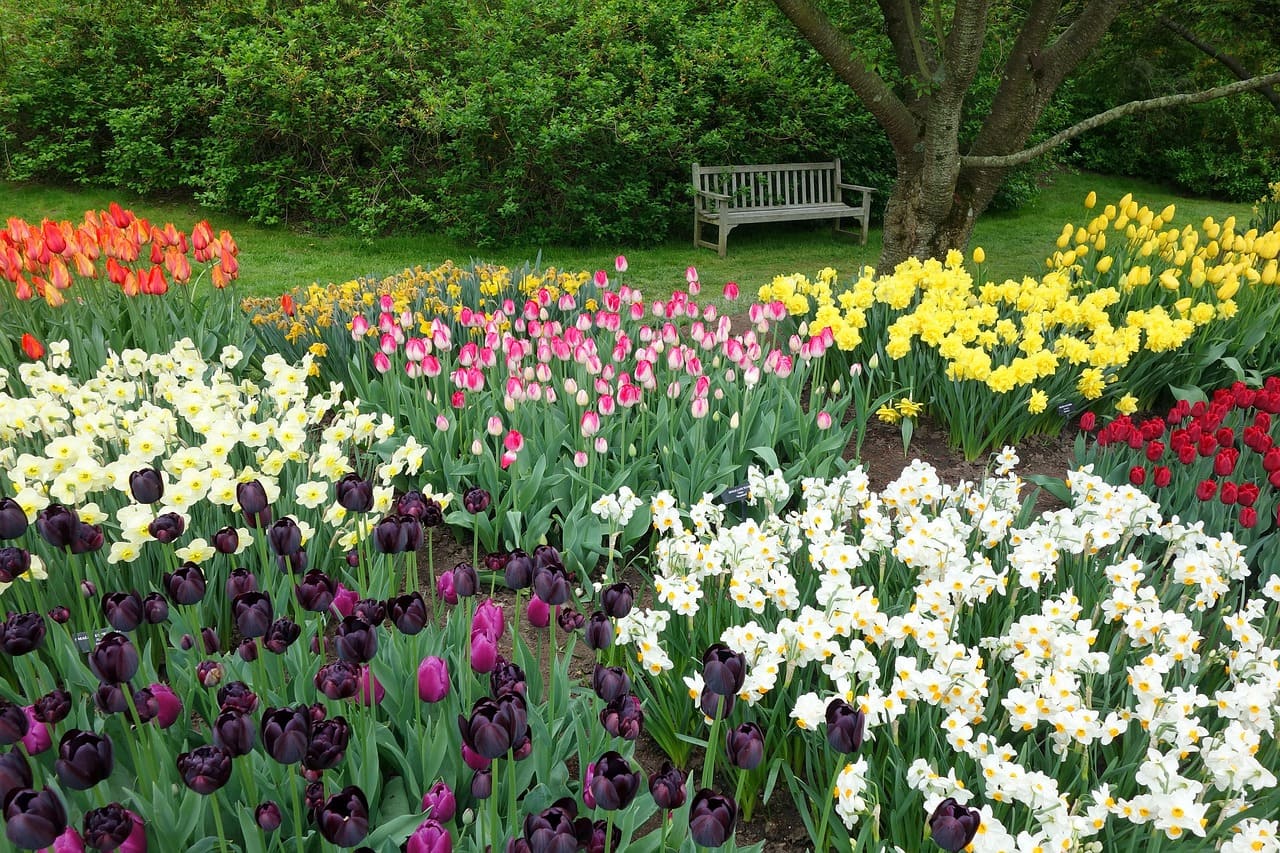
Orchestrating Your Garden’s Beauty
Aesthetic Considerations: Harmonizing flower choices with your garden’s personality.
When it comes to creating a breathtaking garden, aesthetics play a crucial role. The flowers you choose should harmonize with your garden’s unique personality. Alliums and narcissus, with their striking appearances and vibrant colors, offer a wide range of aesthetic possibilities. ‘Globemaster’ alliums, with their royal purple hue, can add a touch of regal elegance to your garden. The majesty of ‘Mount Everest’ alliums, standing tall in pristine white, can infuse an air of serenity and purity. The dramatic flair of ‘Atropurpureum’ alliums in deep burgundy-red can bring intensity and contrast. In the world of narcissus, ‘King Alfred’ daffodils herald a classic touch of timeless beauty, ‘Pink Charm’ daffodils contribute gentle whimsy, ‘Jetfire’ daffodils create a vibrant and energetic atmosphere, while double-flowered daffodils like ‘Tahiti’ and ‘Acropolis’ add an opulent and sophisticated dimension.
Seasonal Flourish: Planning for a year-round blooming spectacle.
Your garden should be a spectacle of beauty throughout the seasons. By selecting the right varieties of alliums and narcissus, you can ensure your garden flourishes year-round. Alliums typically bloom in late spring to early summer, enriching your garden with their colors and shapes. Narcissus, especially early-blooming varieties like ‘Jetfire,’ usher in spring’s arrival. By planting a combination of these varieties, you can orchestrate a year-round display of floral beauty. With careful planning and selection, your garden will delight with colors, fragrances, and shapes in every season.
Creating Symphonies: The art of combining Alliums and Daffodils in your garden.
The true magic of your garden lies in the art of combining these floral wonders. Alliums and narcissus can coexist harmoniously, each enhancing the other’s beauty. The tall, architectural form of alliums can act as an elegant backdrop to the clusters of narcissus blooms. For example, planting ‘Globemaster’ alliums behind ‘King Alfred’ daffodils creates a majestic focal point. ‘Mount Everest’ alliums provide a pristine canvas for ‘Pink Charm’ daffodils to exhibit their gentle whimsy. The contrast of ‘Atropurpureum’ alliums with ‘Jetfire’ daffodils can create a dramatic flair. And the opulence of ‘Tahiti’ and ‘Acropolis’ double-flowered daffodils can be enhanced when nestled among alliums. These combinations form a symphony of colors and textures in your garden, making it a dynamic and ever-changing work of art.
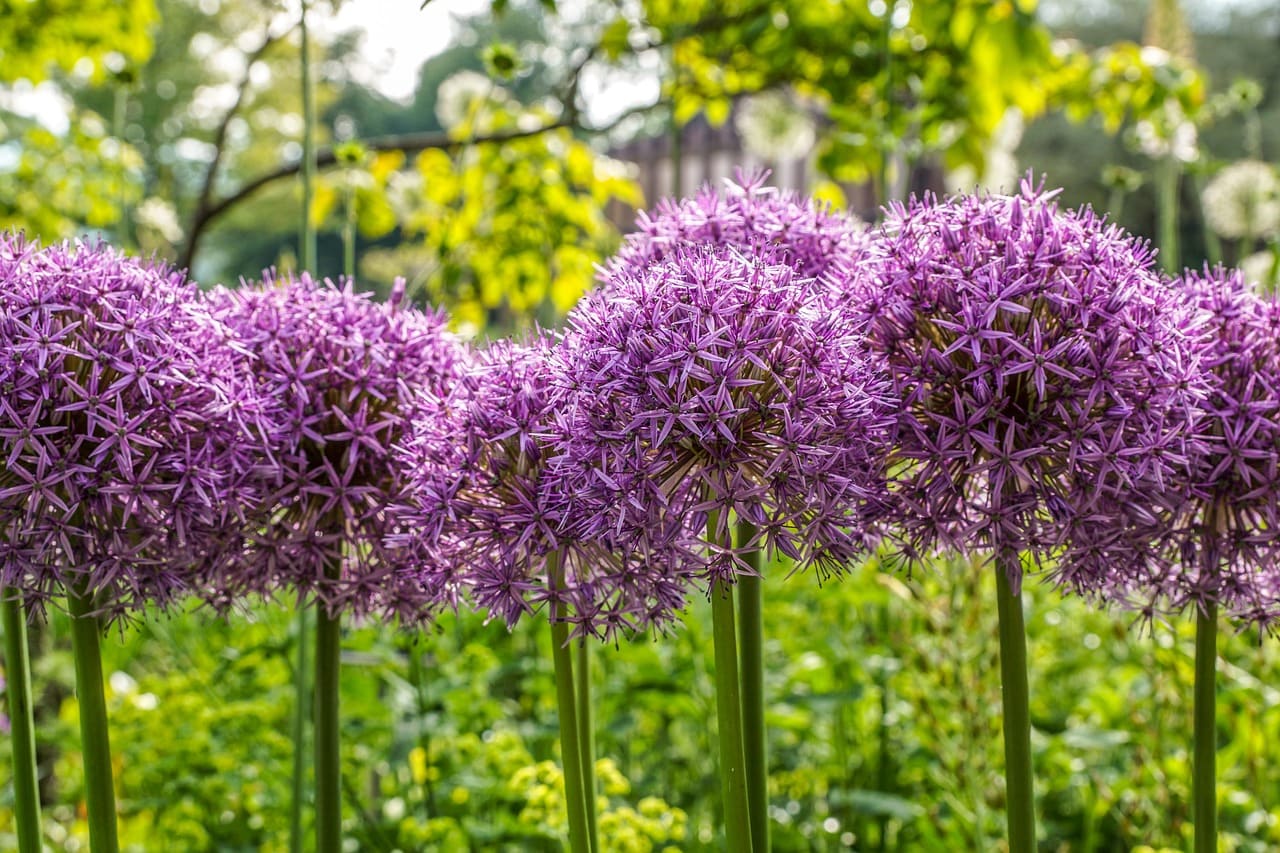
Nurturing the Floral Symphony
Planting and Care: Tips to ensure the health and vitality of your blooms.
Your garden’s beauty largely depends on how well you care for it. Alliums and narcissus, while striking, require some attention to ensure they thrive. Here are some care tips to help you nurture the floral symphony in your garden:
Planting Alliums:
- Plant in Fall: For most allium varieties, fall is the best time to plant. This allows the bulbs to establish roots before the growing season.
- Well-Drained Soil: Alliums dislike sitting in waterlogged soil. Ensure your garden soil is well-draining to prevent rot.
- Sunlight: Alliums love sunlight. Plant them in areas that receive full sun for at least 6-8 hours a day.
- Spacing: Follow the planting instructions on the bulb packaging for proper spacing.
Planting Narcissus:
- Plant in Fall: Much like alliums, narcissus bulbs should be planted in the fall.
- Depth: Plant the bulbs at a depth equal to three times their height.
- Soil and Sun: Well-draining soil and full sun are ideal conditions for narcissus.
- Divide and Refresh: Over time, narcissus bulbs can become overcrowded. Divide and replant them every few years to ensure healthy blooms.
Tending to Challenges: Addressing common pests and issues gracefully.
Gardens are susceptible to various challenges, including pests and diseases that can affect alliums and narcissus. Being proactive in addressing these issues will help maintain your garden’s beauty:
Pests:
- Bulb-Eating Animals: To deter animals like squirrels or voles, use wire mesh or protective covers when planting bulbs.
- Aphids: These tiny insects can attack alliums and narcissus. Rinse them off with a strong jet of water or use insecticidal soap.
Diseases:
- Fungal Issues: Ensure proper spacing between bulbs to improve air circulation and reduce the risk of fungal diseases.
- Botrytis: Can affect narcissus leaves and flower stalks. Remove affected foliage and improve ventilation.
Water-Wise Elegance: Balancing the beauty of your garden with water conservation.
In an era where water conservation is paramount, it’s essential to balance the beauty of your garden with responsible water use:
Efficient Watering:
- Use soaker hoses or drip irrigation to deliver water directly to the root zone, minimizing wastage.
- Apply mulch around your bulbs to retain soil moisture and reduce evaporation.
Watering Schedule:
- Water deeply but less frequently. Allow the soil to dry slightly between watering, as both alliums and narcissus prefer well-drained soil.
Your garden, under the expert guidance of your landscape designer in Atherton, is a canvas for natural beauty. Alliums and Daffodils, with their vibrant personalities and unique charm, are ready to turn your outdoor space into a masterpiece. The harmony between these blooms will create a symphony of colors, fragrances, and aesthetics in your garden. Explore their world and let your garden sing its heart out
